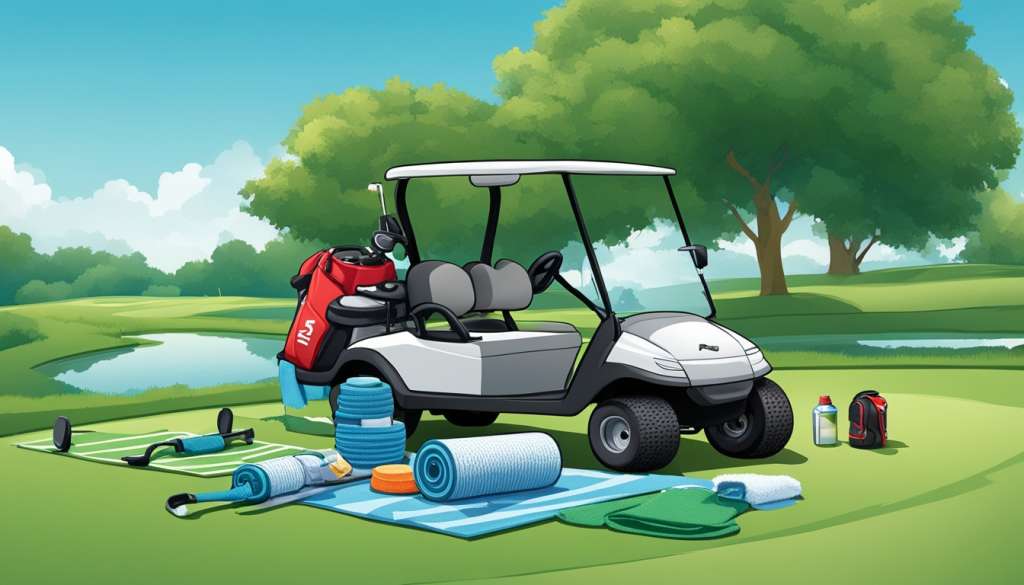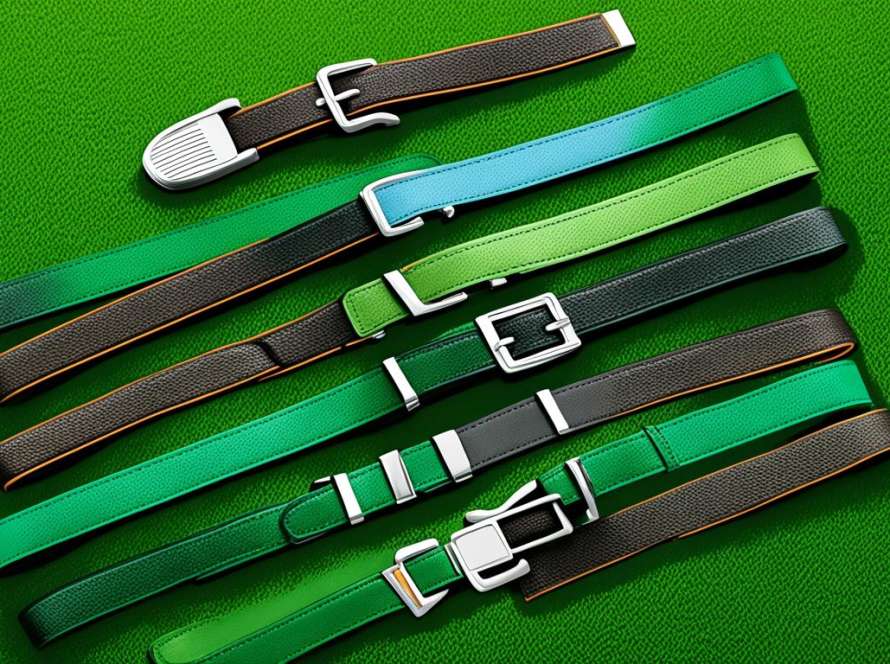After a tough game of golf, having a good plan for recovery is key. This guide will show you how to ease muscle soreness, speed up recovery, and feel ready for your next game. We’ll cover stretching, nutrition, and other tips for effective recovery and pain relief.
Golf requires both physical and mental strength. A good recovery plan can greatly improve how you feel the next day. By focusing on easing muscle soreness and smart recovery, you’ll be ready for your next game with more energy. Let’s explore the key parts of post-round comfort to keep you performing well.
Understanding the Importance of Post-round Recovery
Post-round recovery is key for your golf game. It helps you recover faster and enjoy golf more. Let’s explore why it’s so important.
Physical Benefits of Proper Recovery
After golf, your body needs attention. Proper recovery helps with muscle soreness and improves flexibility. It fixes tiny muscle tears from swinging clubs all day. This can reduce pain and let you play more.
Mental Aspects of Post-round Relaxation
Golf is as much a mental game as it is physical. Taking it easy after a round clears your mind. It helps you think about the game and release stress. This mental break is crucial for staying sharp.
Long-term Impact on Performance and Enjoyment
Regular recovery can improve your game over time. It lowers injury risks and keeps you in shape. Feeling good means you play better and have more fun. Managing pain becomes easier, making each round more enjoyable.
- Reduces risk of long-term injuries
- Improves overall performance
- Enhances enjoyment of the sport
Remember, recovery after golf isn’t just about feeling good now. It’s an investment in your golfing future. Taking care of your body and mind after each round prepares you for many great games ahead.
Immediate Post-round Stretching Techniques
After a tough round of golf, your muscles need some care. Stretching is essential for easing muscle soreness and boosting flexibility. Here are some effective stretches to keep you feeling good on and off the course.
Begin with your upper body. Roll your shoulders back and forth to release tension from swinging clubs. Then, lift your arms behind your back to stretch your chest and shoulders.
Next, focus on your lower body. Stand up straight and bend forward to stretch your hamstrings and calves. Hold this stretch for 15-30 seconds, even if you can’t reach your toes. For your calves, lean against a wall with one foot in front, keeping the other leg straight.
Don’t overlook your back! The cat-cow stretch is great for golfers. Start on all fours, arch your back like a cat, then bend down towards the ground. Do this 5-10 times to loosen your spine.
These stretches are not just for immediate relief. They’re key to reducing muscle soreness and preventing injuries. Make them a part of your routine to enjoy golf for years.
Hydration Strategies for Optimal Recovery
After golf, your body needs the right amount of water to recover well. Smart ways to stay hydrated are crucial for getting better after your game. They can really help your performance on the course. Let’s look at how to refill fluids, keep electrolytes balanced, and pick the best drinks for staying hydrated.
Replenishing Fluids
Playing golf makes you sweat, especially when it’s hot. It’s important to refill these lost fluids for your body to recover. Try to drink 16-20 ounces of water within 30 minutes after you finish playing. This starts the process of getting back hydrated and helps your muscles recover.
Electrolyte Balance
Electrolytes are key for staying hydrated and muscles working right. When you sweat, you lose water and important electrolytes like sodium, potassium, and magnesium. It’s important to get these back to keep your body’s fluid balance and avoid muscle cramps.
Recommended Beverages
Water is great for basic hydration, but sports drinks can help with fluids and electrolytes. Choose drinks with sodium, potassium, and some carbs. Coconut water is also good for its natural electrolytes. Stay away from sugary drinks or alcohol, as they can dry you out.
| Beverage | Benefits | When to Consume |
|---|---|---|
| Water | Basic hydration | Throughout the day |
| Sports Drinks | Electrolyte replenishment | During/after intense rounds |
| Coconut Water | Natural electrolytes | Post-round recovery |
Using these tips for staying hydrated will improve your recovery after your game. It will also get you ready for your next golf round. Remember, drinking water regularly is key to doing your best on the course.
Nutrition Tips for Post-round Refueling
After a tough round of golf, your body needs the right food to recover. Sports nutrition is key for getting back in shape after working out. By following these tips, you’ll recover faster and be ready for your next game.
Try to eat within 30 minutes after your round. This helps refill your energy and start fixing muscles. Go for a mix of carbs and proteins for the best recovery.

- Greek yogurt with berries and granola
- Turkey sandwich on whole grain bread
- Grilled chicken with quinoa and vegetables
- Protein smoothie with fruits and leafy greens
Drinking water or a sports drink is important. It helps replace lost fluids and electrolytes. Don’t have alcohol, as it can slow down your recovery.
| Nutrient | Function | Food Sources |
|---|---|---|
| Carbohydrates | Replenish energy stores | Whole grains, fruits, vegetables |
| Proteins | Support muscle repair | Lean meats, fish, eggs, dairy |
| Antioxidants | Reduce inflammation | Berries, leafy greens, nuts |
Sticking to good nutrition habits helps improve your performance over time. By focusing on eating well after your round, you’re helping yourself do better on and off the course.
The Role of Rest and Sleep in Recovery
Rest and recovery are key for athletes, especially after a tough golf game. Good sleep helps your body and mind get ready for top performance.
Importance of Quality Sleep
Good sleep is a must for athletes to bounce back and perform well. Deep sleep fixes muscles, makes memories stronger, and balances hormones. This is crucial for getting back in shape after a hard golf game.
Recommended Sleep Duration
Most athletes need 7-9 hours of sleep each night. Sticking to a regular sleep schedule is important, even when you’re not golfing. This keeps your body clock in check and makes sleep better.
| Age Group | Recommended Sleep Duration |
|---|---|
| Adults (18-64) | 7-9 hours |
| Athletes | 8-10 hours |
Creating an Optimal Sleep Environment
To get better sleep, make your bedroom sleep-friendly. Keep it cool, dark, and quiet. Choose a comfy mattress and pillows that keep your body right. Avoid blue light from devices before bed, as it can mess with your sleep.
- Use blackout curtains to block light
- Set the thermostat between 60-67°F (15-19°C)
- Use white noise machines to mask disruptive sounds
- Avoid caffeine and heavy meals close to bedtime
Putting rest and recovery first through good sleep will boost your golf skills and overall health. Remember, sleep is a key tool for athletes to excel in golf and life.
Massage and Self-myofascial Release Techniques
After golf, your muscles need some care. Massage therapy and self-myofascial release can help a lot. They ease muscle tension, boost blood flow, and help you recover faster.
Massage therapy means a pro works on your muscles. They use strokes to relax tight spots and improve blood flow. This can lessen soreness and make you more flexible.
Self-myofascial release is something you can do at home. It’s a self-massage using tools like foam rollers or massage balls. By applying pressure to certain spots, you can release muscle knots and tension.
Effective Self-myofascial Release Techniques
- Foam rolling: Roll slowly over major muscle groups
- Tennis ball massage: Press a tennis ball into tight spots
- Lacrosse ball for deep tissue work: Use on stubborn knots
Begin with light pressure and slowly increase it. Focus on spots that feel tight or sore. Spend 30-60 seconds on each area.
| Technique | Benefits | Best for |
|---|---|---|
| Massage therapy | Deep muscle relaxation, improved circulation | Overall body recovery |
| Foam rolling | Release muscle tension, improve flexibility | Large muscle groups (legs, back) |
| Ball massage | Target specific knots, deep tissue work | Small areas (feet, shoulders) |
Being consistent is important. Add these techniques to your routine after golf for the best results. Your body will reward you with better performance and less pain on the course.
Ice Baths and Contrast Therapy: Pros and Cons
Ice baths and contrast therapy are popular among athletes for recovery after exercise. They have benefits and drawbacks. Let’s look at the good and bad sides of cold therapy to help you choose the best recovery plan.
Benefits of Cold Therapy
Cold therapy, like ice baths, can lessen inflammation and muscle soreness after hard exercise. The cold makes blood vessels smaller, which reduces swelling and pain. Many golfers say ice baths help them recover faster, so they can play sooner.
How to Properly Use Ice Baths
To get the most from ice baths:
- Fill a tub with water at 50-59°F (10-15°C)
- Immerse your body up to your waist for 10-15 minutes
- Gradually increase exposure time as you get used to the cold
- Always listen to your body and exit if you feel uncomfortable
Contrast Therapy Techniques and Benefits
Contrast therapy switches between hot and cold. It boosts circulation and eases muscle stiffness. A common routine is 1 minute in a hot tub, then 30 seconds in an ice bath, repeated 3-4 times.
| Method | Pros | Cons |
|---|---|---|
| Ice Baths | Reduces inflammation, speeds recovery | Can be uncomfortable, risk of hypothermia |
| Contrast Therapy | Improves circulation, reduces stiffness | Time-consuming, requires both hot and cold setups |
While cold therapy has benefits, talk to a healthcare professional before using it for recovery. What works for one golfer might not work for another. Everyone’s body is different.
Post-round Comfort Guide: Essential Equipment and Tools
After a tough round of golf, your body needs relief. The right recovery gear can change everything. Let’s look at some key tools to help you feel better and recover faster.

Foam rollers are great for golfers. They help ease muscle tension and boost flexibility. Roll your back, legs, and shoulders to help with stiffness. Massage balls are also great for smaller muscle groups like your feet and hands.
Compression gear is also a must-have. Wear compression socks or sleeves to help blood flow and reduce swelling in your legs and arms. This is especially good if you walked the course.
A stretching strap is another important tool. It helps you stretch deeper, especially in hard-to-reach spots like your hamstrings and back. Use it to gently stretch and ease muscle tightness.
| Recovery Tool | Primary Benefit | Best Used For |
|---|---|---|
| Foam Roller | Muscle tension release | Back, legs, shoulders |
| Massage Ball | Targeted relief | Feet, hands, small muscle groups |
| Compression Gear | Improved circulation | Arms, legs |
| Stretching Strap | Deeper stretches | Hamstrings, back |
Invest in a good ice pack or heat wrap for temperature therapy. Cold helps reduce swelling, while heat eases sore muscles. Switch between them for the best effects.
Using these post-workout tools regularly is key to recovery. Add them to your routine to stay at your best on the golf course.
Active Recovery: Light Exercises for the Next Day
After a tough game of golf, your body needs to recover. Light exercises can help you get back in shape quickly. These activities improve blood flow, ease muscle tightness, and keep you flexible without pushing too hard.
Begin your recovery with a gentle walk. This easy exercise helps your blood move and eases tight muscles. Try to walk for 15-20 minutes at a slow pace. You can walk outside or on a treadmill, whichever feels best.
Then, move on to some light stretching. Focus on your back, shoulders, and legs, which often get tight after golf. Hold each stretch for 15-30 seconds without bouncing. This helps you stay flexible and lowers injury risk for future games.
Swimming or water aerobics are great for active recovery. The water’s buoyancy eases joint stress and offers gentle resistance. Spend 20-30 minutes swimming or doing water exercises to boost circulation and aid muscle recovery.
Yoga is another great choice for post-golf relaxation. Pick a gentle or restorative yoga class that focuses on breathing and calming down. It helps with both physical and mental recovery, getting you ready for your next game.
Remember, the goal of active recovery is to keep it easy. Pay attention to your body and don’t overdo it. By adding these light exercises to your routine, you’ll recover faster and be ready for your next golf outing.
Conclusion
Your post-round recovery routine is crucial for better golf performance. This guide will help you care for your body after a tough game. Stretching, staying hydrated, and eating right are key to quick recovery.
Rest and sleep are also crucial for getting back in shape. Good sleep helps your muscles heal and gets you ready for the next game. Massage and active recovery can also help your body heal faster.
Putting recovery first means you’ll do better in the long run. You’ll feel great, play better, and enjoy golf more. Start using these tips in your routine now and see your golf skills improve.

